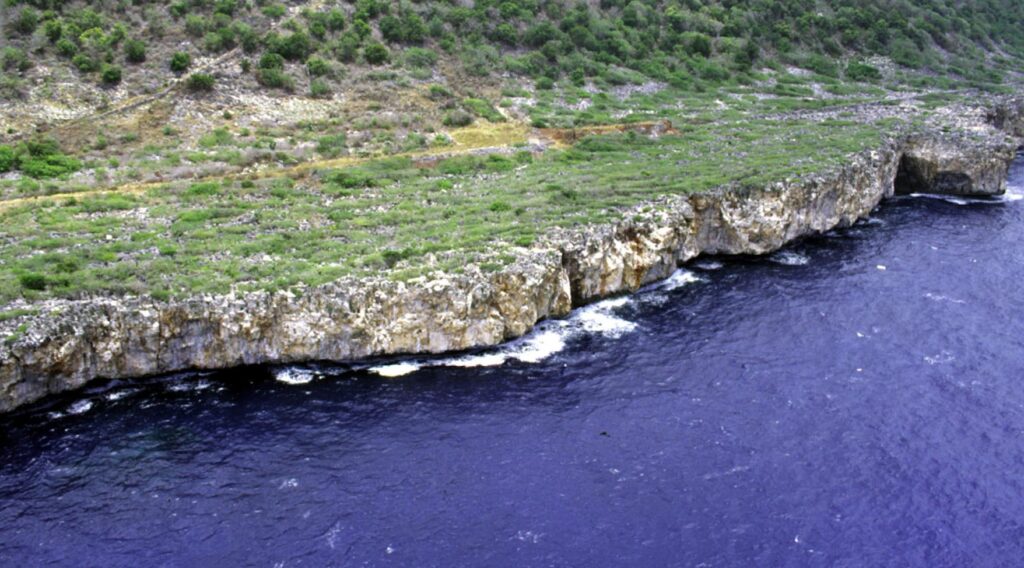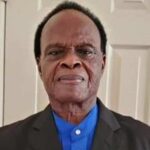Navassa Island is a small, uninhabited island located between Haiti, Jamaica, and Cuba. Originally acquired for its guano resources, today, Navassa is of no apparent use to the United States. A review of the island’s history and geography suggests several possibilities for Navassa’s future and America’s own interests in this remote territory.
Situated near the southern end of the Windward Passage, uninhabited Navassa Island is two square miles of wind-beaten brush struggling to grow among limestone and long-dead coral. Forty miles from Haiti, 85 from Jamaica, and 130 from Cuba, its waters can be reached by mariners with relative ease. However, Navassa’s abrupt, sharp coral cliffs prevent easy access to its terrain. Today, the only regular visitors are fisherman from Haiti’s southwest coast, who rarely make landfall. Navassa is a harsh and unappealing place. It is also American territory.
Navassa was acquired by the United States under the Guano Islands Act of 1856. That statute granted private citizens the right to claim terra nullius under the authority of the United States government if such locations were suitable for phosphate extraction. Today, the United States retains nine islands acquired under the Act, of which eight are in the Pacific. Navassa is the nearest to the U.S. mainland. Like the other guano islands, Navassa is legally designated as a U.S. Minor Outlying Island. This designation formalizes American sovereignty over Navassa, albeit in a somewhat vague fashion.
Guano: The New Gadsden
Guano, excrement deposits from primarily birds and bats, was mined in North America from the colonial period. In addition to its importance as a fertilizer, guano was valued as a source of saltpeter—an essential element of black powder. By the mid-19th century, however, most guano deposits in the United States were near exhaustion. During an era when American mariners were scouring the globe for whale oil, though, it was only a matter of time before reports filtered back to Congress of remote islands literally covered in bird guano. Reflecting upon the importance of distant guano deposits, President Fillmore opined in 1850 that it was “the duty of the Government” to secure it at “a reasonable price.”
In 1854, the Gadsden Purchase finalized the composition of the lower 48 states. But America’s empire would not be limited to the landmass between the Atlantic and the Pacific. In 1856, Congress passed and President Pierce signed the Guano Islands Act. The new law sent a host of adventurous Americans on a crusade to claim remote islands under the color of the U.S. flag. One of the first of these new possessions was Navassa, claimed in September 1857 by Captain Peter Duncan.
Small Island, Big Profits—and Problems
Duncan and his employers acquired Navassa as a financial speculation. Initially, it seemed a sound investment—but there were challenges. Not much more than a pear-shaped rock, the island’s chief topographical feature was “The Mountain,” a 100-foot-high heap of guano deposited by passing birds over several millennia. Removing this mass of wealth, though, was a difficult endeavor.
Reaching Navassa was not difficult. The island was likely first discovered by a group of Columbus’ men, who chanced upon it in 1504 while transiting from what is now Jamaica to present-day Haiti. They sailed past the island, naming it “Navaza,” and continued east without formally visiting their discovery. Until Captain Duncan’s 1857 visit, the little island remained mostly ignored—though not without good reason.
Landing on Navassa was tremendously difficult, as its new American owners soon found in 1857 when mining commenced. Surrounded by cragged, sharp 50-foot cliffs, early access was gained by tossing a grappling hook onto the island and then slowing hoisting oneself above its shark-filled waters. Once atop, the view was sobering. The region’s semi-arid climate, marked by periods of lengthy drought followed by occasional tropical storms, fostered a harsh, nearly unlivable environment. The vegetation was cactus-like. Natural water sources were nonexistent. The only animals present were small snakes, lizards, and the ubiquitous, always defecating birds.
But demand for guano was high, and the owners set to work mining. Two “harbors” were established by dynamiting cut-outs into the side of the island, permitting goods and workers to be brought ashore via block and tackle. Despite the hardship, Navassa was profitable. Operations were sold in 1865 to the newly formed Navassa Phosphate Company for $200,000. The Company, aiming to increase revenues further, replaced contracted American convicts with the only labor cheaper than prisoners: recently emancipated blacks.
The Navassa Revolt
Roughly 150 workers and 15 managers were assigned to Navassa. Working conditions were horrific. After deposits from The Mountain were exhausted, laborers dug into Navassa itself to extricate guano from the honeycomb of limestone beneath them. Pay was minimal, conditions were abysmal, and supervision was practically antebellum. The Company hired former slave overseers to mind the former slaves, and the results were predictable.
In 1889, several black workers revolted, killing three white supervisors. 18 blacks were returned to Baltimore and indicted for murder in federal court. The case invoked near-endless questions of jurisdiction, as well as discussions in the press about Reconstruction and the nascent labor movement. Following their conviction and failed Supreme Court appeal, the defendants’ death sentences were commuted by President Harrison.
Mining resumed on Navassa, although with reduced profitability.
Problems Offshore
Beyond its diminishing guano reserves, massively altered landscape, and now criminal reputation, the acquisition of Navassa presented the American government with other concerns.
The Guano Islands Act, unsurprisingly, created immediate foreign tensions. In the Pacific, where American privateers laid most of their guano claims, there were inevitable dustups with the British, Dutch, and French. The Caribbean was a slightly easier environment for the Americans, given Spain’s weakened condition and the impotence of newer states in the region. Privateers staked the red, white, and blue in islands off the coasts of Honduras, Nicaragua, and Venezuela with minimal resistance. Navassa though was troublesome because of its nearness to very poor but very proud Haiti, which made a vocal attempt to protest America’s arrival.
The Haitian governments (which rose and fell as regularly in the 19th century as they did in the 20th) consistently argued that America’s claims to Navassa were illegal. Unfortunately for the Haitian legal position, their assertions began only after the Americans started mining Navassa. Even more damaging to Haiti’s claims, history suggests Navassa was likely terra nullius.
Haiti has always asserted that Navassa was discovered by Columbus’ men on behalf of the Spanish throne. It was later conveyed, claim the Haitians, to the French. Upon expelling the French then, Haiti became Navassa’s rightful owner. “Lavash,” as Navassa is called in Haitian Creole, has always been an integral part of their territory.
By some estimation, Haiti’s claims to the island appear reasonable. Haiti is geographically closer to Navassa than any other country (and it is certainly nearer to Navassa than the United States, Florida being situated some 600 miles from the island). France did indeed acquire Hispaniola from Spain, and the Haitians, quite decisively, won freedom from France. Cartographical support for the Haitian position, however, an essential element in claims of territory, is less clear. An examination of maps of the region indicates Navassa was known, but possibly never formally claimed.
The earliest maps of the Caribbean do not show Navassa. While Columbus’ journals indicate the island was known, it was not marked in either Benedetto Bordone’s 1528 woodcutting of the region (pictured below) or Thomaso Porcacchi’s 1530 atlas, two early Venetian works publicizing Columbus’ finds.
For over two centuries, Dutch, French, Spanish, Portuguese, and English maps failed to expressly indicate Navassa’s status (if Navassa was noted at all). When Navassa’s existence was included, it was typically as a mere dot and, as was common during the period, it was surrounded by nonexistent islands. When France acquired the western half of Hispaniola from the Spanish at the conclusion of the Nine Years War in 1697, there was no mention of Navassa in the treaty detailing terms.
In 1765, French mapmaker Jacques Bellin published a popular atlas of the French Empire. Included was a map of Hispaniola as it was understood at the time of Columbus’ discovery.
Bellin’s map of the lands encountered by Columbus indicates the presence of Navassa but does not state Spanish ownership one way or another. Bellin’s map of French acquisitions in his atlas, though, includes Navassa and expressly labels it as French. This suggests, at least in popular opinion in the 18th century, the French considered Navassa their territory.
Haiti’s first constitution, ratified in 1804, claimed “the adjacent islands” of Saint Dominque (the French label for Hispaniola). However, that document did not delineate specifically which islands were claimed. It was not until 1874, well after guano mining had commenced, that the Haitian constitution was amended to include Navassa specifically. Prior to then, the Haitians evinced no public interest in Navassa.
In fact, the American mining efforts went unnoticed in Port-au-Prince until a disgruntled partner in the enterprise tipped off Haitian Emperor Faustin in 1858. Faustin was intrigued and wrote to the governor of Jamaica seeking support. The governor agreed to back the Haitian claim in spirit, though no formal British intervention was promised. Faustin determined then to act alone, sending two Haitian craft to Navassa. Their presence was so unintimidating that the Americans simply continued mining until the arrival of the U.S. Navy soon after, a development that scared away the Haitian vessels. Faustin backed down and thus concluded the only concrete action Port-au-Prince ever took toward Navassa.
The Haitians did make a formal protest to the Americans, though. Haiti’s commerce agent in New York objected to America’s Navassa claim in an 1858 letter to the State Department (Haiti and the United States had no formal bilateral relations until after the Civil War because of Southern objections). The Americans merely ignored it.
Equally damaging to Haiti’s claim, though, was the reality that governments in Port-au-Prince simply had never manifested any interest in locations offshore. Haiti’s several islands had historically been neglected by those in power in Port-au-Prince. An example emerges from the 1914-1934 American occupation of Haiti. In 1928, U.S. Marine sergeant Faustin Wirkus was posted to La Gonave, a 40-mile-long island in Port-au-Prince Bay. In March, he recorded “the first visit in history of a president or other ruler of Haiti” to the island.
If the leaders of Haiti had historically ignored a major island just minutes from Port-au-Prince, it follows then that they would have paid little attention to far off, unprofitable Navassa.
Even if Navassa was sought by the Haitians, though, practically, their governments have never been able to do anything more than shout. After 1958, Castro’s Cuba voiced support for Haiti’s position, but no votes materialized in the U.N., and no demarches were forthcoming to Washington from foreign powers. In recent years, leftist governments from Caracas to Managua to Quito have also joined the cause via presidential statements. But actual action has never materialized. At present, Haitian naval forces consist of coast guard patrols (largely financed by the United States). While claims of injustice toward Haiti and its rightful ownership of Navassa are commonplace in Port au Prince today, very little has been done to move those claims forward. Realistically, Haiti has no control over Navassa’s fate.
Modern Concerns
There are other worries for the United States regarding Navassa though, beyond Haiti’s toothless claims.
Navassa could become a target for a group or state seeking to make a statement against the United States. The landing, for example, of a hostile military element onto Navassa might attract some attention. Such a gesture is not unimaginable. The Venezuelans have zealously guarded their sovereignty over Aves Island, a sandy atoll briefly claimed under the Guano Islands Act in the late 1800s before its surrender to Caracas. The matter is occasionally brought up in Venezuelan political discourse.
As a platform for intelligence operations, Navassa has some theoretical value. While hundreds of miles from Florida, it is only slightly more than one hundred from Guantanamo Bay. During both World Wars, the U.S. Navy stationed observers on Navassa, fearing German interference (indeed, Haiti’s early 20th century occupation by the United States was in part precipitated by fear that the Germans might use Haiti as a safe haven from which to harass Windward Passage shipping). A lighthouse was built by the United States in 1916 and occupied until 1929 when it was automated. And while Navassa has no airstrip, it is an ideal location for stashing narcotics and other illicit materials moving north from South America.
But the greatest risk from Navassa, from an American and broader perspective, is to its rich marine ecosystem. While the island itself is now flattened, denuded, and by many measures an environmental tragedy, its surrounding waters are pristine—though in jeopardy. Haitians overfish Navassa, particularly when times are especially hard in Haiti. A 2005 study determined that in the 24 months prior, visits to Navassa’s coastline by Haitian fishing vessels had more than doubled, resulting in a marked decline in marine biomass. That increase in environmental stress mirrored the de facto civil war and then demise of the second Aristide government, a particularly difficult period economically in a place that is accustomed to such hardship.
Navassa’s Future
The good news about Navassa Island is that practically no one cares about it, and nothing too serious is on the line. As outlined, Navassa could theoretically be exploited by foreign powers or drug runners. Unfortunate as such a development might be, it would hardly amount to a major threat to American interests. And as wonderful as it would be to increase protection of Navassa’s reefs and ocean life—both could all disappear tomorrow and not make any difference whatsoever to most Americans. Even the lighthouse at Navassa is no longer that critical, given modern shipping’s employment of GPS and other technologies.
As such, one wonders why the United States, which administers matters related to Navassa through the Department of Interior, should even maintain possession of the island—if it even does. Per the Guano Islands Act, Navassa is an “appurtenance” of the United States, though that term is somewhat murky in the case law. The Supreme Court’s 1890 decision upholding the death sentences of eighteen participants of the Navassa Revolt determined that private claims to Navassa should be protected by the Navy but left open the question of what federal obligations remain once guano mining ceased. Given that mining ended over 100 years ago and Navassa’s complete unimportance to the United States, one course of action might be simply to abandon the place.
This would be unwise, primarily because of the precedent it would establish. It is a near axiom of foreign policy that states do not willingly surrender territory. America has steadfastly claimed Navassa for almost two centuries. To walk away now might suggest other, more important territories could also be abandoned. Give up Navassa today, face questions about Midway tomorrow. Abandonment would also surrender any future use Navassa might offer. Navassa’s location is potentially strategically valuable. While now it is of no use to Washington, perhaps at some point, a new technology might create value in Navassa.
The other option would be to surrender Navassa to Haiti. As detailed though, Haiti’s claim to the island is contestable. Passing off land to other states gratuitously weakens America’s position when arguing about other territory. Further, Haiti’s ability to administer Navassa is inadequate. While the United States would likely intervene in a Haitian-owned Navassa to thwart a Venezuelan presence and might do so to shut down a narcotics operation, giving up Navassa would relinquish its environmental mandate and severely jeopardize the island’s ecosystem. (Americans have never enthusiastically supported foreign intervention for ecological reasons). Transferring Navassa to Haiti would be an invitation to Chinese and other trawlers to assault the island’s rich ocean resources.
Accordingly, America’s smartest approach to Navassa is not to change course. Maintaining the status quo is nearly cost-free. The United States has no fixed presence on Navassa. Other than occasional U.S. Coast Guard visits, the island requires no significant supervision. Permission to visit Navassa technically requires a permit from a Fish and Wildlife office in Puerto Rico, though such requests are uncommon. Leaving the island as it is prevents any weakening of U.S. claims to other territories, gives a modicum of protection against illegal fishing and other nefarious behavior, and preserves any possible future strategic use of Navassa.
This paper was written by Nick Pietrowicz for Geography and Strategy (IWP 634) with Dr. Marek Jan Chodakiewicz. Mr. Pietrowicz is a Supervisory Special Agent with the State Department’s Diplomatic Security Service. He has served overseas tours in Haiti, Afghanistan, Moldova, Chad, Angola, and Australia. For the 2020 academic year, he is a State Department Fellow at IWP.
The views expressed in this article are those of the author and do not necessarily reflect those of the U.S. Department of State or the U.S. Government.



